As the smoke clears from Maui’s deadly wildfires, experts point to productive agricultural land as a hedge against future disasters in Hawaii.
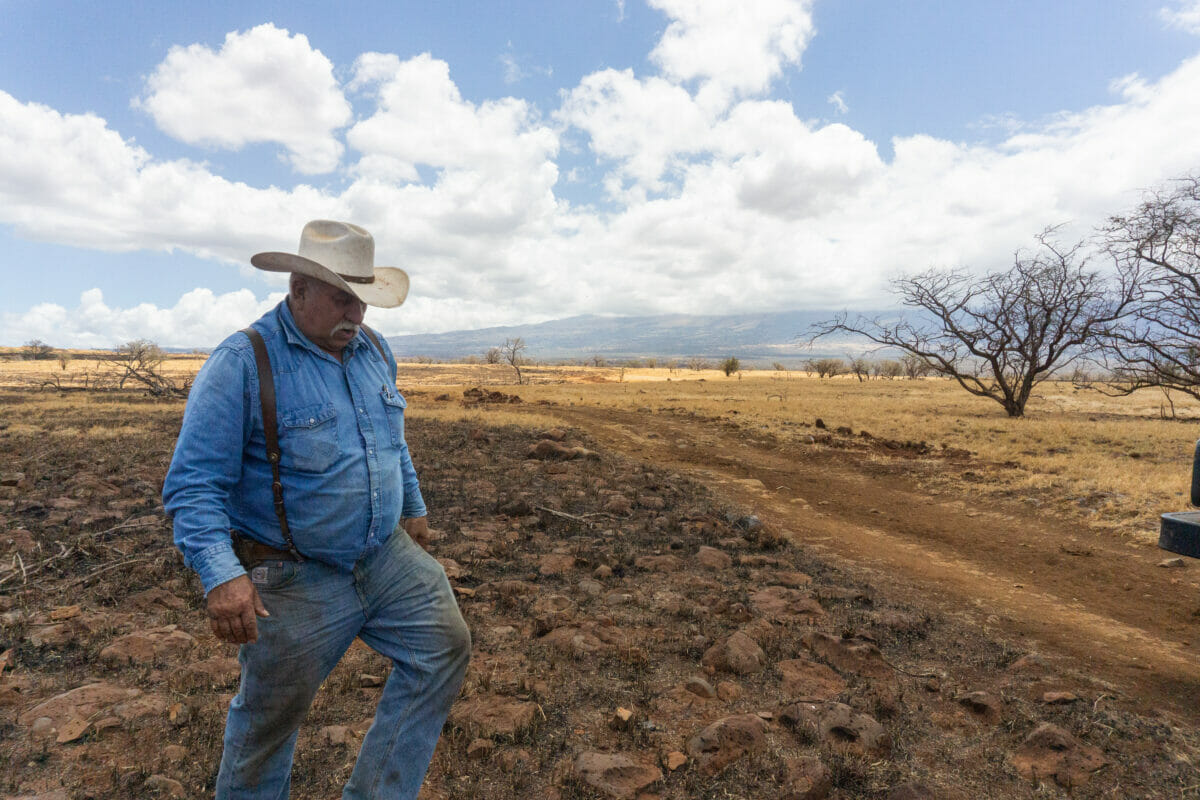
Surveying the aftermath of the Kula Upcountry Fire—one of three devastating wildfires that raged across Maui last month—Brendan Balthazar noticed a striking pattern emerge across his cattle ranch. Peppered throughout some 500 acres of charred pastureland, he found sizable patches of grass left unscathed by the blaze.
“The fire burned right around them,” says the 73-year old rancher and owner of Diamond B Ranch, noting the intact areas—some as big as a quarter acre. “It’s all grazed pasture,” he says, spared “because the fuel load was low.”
But elsewhere, fields of fire-prone grasses had made conditions ripe for combustion, says Balthazar. Introduced to the islands decades ago as livestock forage, invasive vegetation such as Guinea grass and buffelgrass proliferate in the islands, largely on unmanaged agricultural land. And with the state in prolonged drought, the dense, often chest-high growth has turned vast swaths of land, he says, into “one tinder box.”
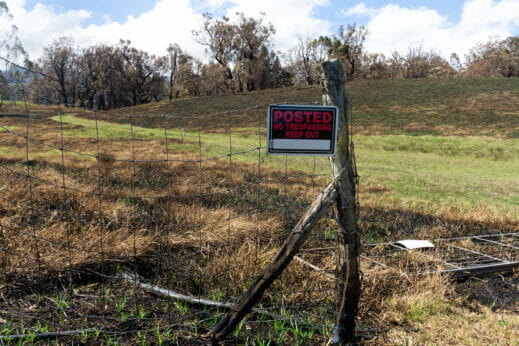
Some areas of grazed pasture on Diamond B Ranch went unburned. (Photo: Jasmine Pankratz)
Once home to large-scale plantations and ranches that dominated the landscape for more than 160 years, the steep and steady decline of Hawaiian agriculture has left fields and pastures idle by thousands of acres, often in close proximity to residential development. Left unchecked, they’re fertile ground, experts say, for harboring fecund grasses and other non-native plants, trees and even deer.
Amid a warming planet and increasingly volatile climate patterns, many see the role of agriculture as essential in minimizing the threats facing the remote archipelago. Keeping fields productive is an essential land management strategy, experts say, while encouraging a diversity of agricultural uses builds resilience in both the land and Hawaii’s food system.
Still, “ag here is a tough business,” says Balthazar. Earlier this year, he lost nearly 60 percent of his land after the lease owner, a private family trust, sold the property to the state. With thick groves of wattle trees, blackberry bushes and other invasive plants “infesting” nearby Polipoli State Park, he has little faith that the 2,100-acre parcel will be properly managed, he says, and fears that he’ll be facing greater fire risk.
“That’s the fight I’m in,” Balthazar adds. “And remember, we live on an island. We only have so much ag land, and we keep losing it.”
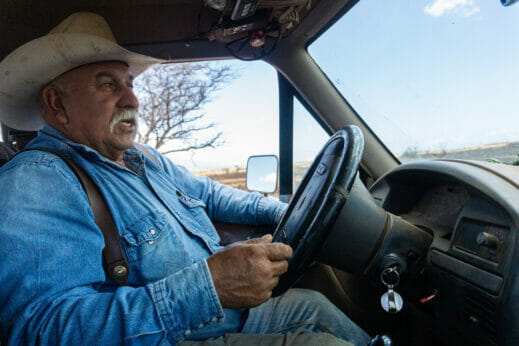
Brendan Balthazar surveys the fire impacts on the land he manages. (Photo: Jasmine Pankratz)
Wildfires, for most of Hawaii’s history, have been rare. But in the past decade, decreasing rainfall and climbing temperatures have left the drier, leeward stretches of its islands—areas in the rain shadow of steep, volcanic mountains—increasingly parched. Meanwhile, the prevalence of intense tropical storms has been ticking up; many are unseasonal, and kick up gale-force winds that can easily stoke a blaze across the arid landscape.
Climate variability has an undeniable role in setting the scene, says Giuseppe Torri, professor of atmospheric sciences at the University of Hawaii (UH) at Mānoa. Some factors are human-induced, while others fall into natural cycles; El Niño, for instance, creates periodic swings in ocean surface temperatures, creating global impact on weather and precipitation patterns.
Nevertheless, tracing the origins of the recent fires to any one cause is difficult, says Torri. Ultimately, hurricanes and high-pressure systems are “large-scale dynamics that occur at a planetary scale”—and unlikely to be influenced by local processes.
Any modification in land use, however, has an impact on the islands, says Torri. “Urbanization, the conversion of native forest to agricultural land, these are all factors that must have played some role not necessarily on the wildfires but on the climate of Hawaii.”
Regardless, “islands are extremely vulnerable to extreme climates and weather phenomena,” says Torri. With average temperatures and sea level both predicted to rise, disasters can come in many forms. “Preparedness seems like a pretty big topic for an island chain in the middle of the Pacific Ocean.”
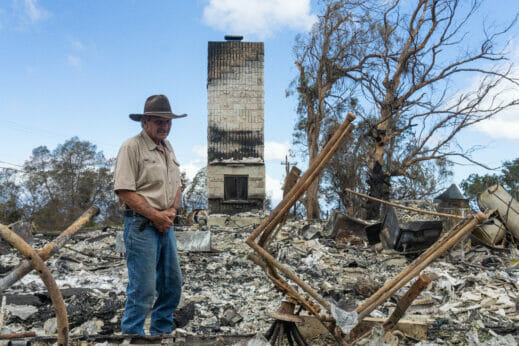
Doug Wagner stands next to what’s left of his home in Kula. (Photo: Jasmine Pankratz)
The colonization of Hawaii in the 19th century led to a dramatic transformation in the island landscape. The privatization of land in the 1850s gave rise to large sugarcane and pineapple plantations—a huge divergence from Native practices of sustainable and diverse farming on communally held plots.
The sugar industry soon dominated the island economy. By the early 20th century, Hawaii was home to 14 commercial sugarcane plantations; at its peak, the crop covered 89,000 acres on Maui alone or nearly a fifth of the island. Yet, falling sugar prices in the 1970s—a result of foreign competition and the elimination of import restrictions and excise taxes—marked the eventual demise of the industry.
In 2016, HC&S, the state’s last sugar plantation, shuttered its Maui operations. Although Hawaii’s overall agricultural footprint had been shrinking for nearly four decades, the closure took nearly 38,000 acres of fields out of production in one fell swoop. According to a UH study, that contributed to an 82-percent drop in Maui’s active cropland between 2015 and 2020—despite a 3,000-acre increase in diversified crops during the same time period.
“When the last sugarcane plantation closed, there was real concern about what that landscape would become,” says Laura Brewington, an Arizona State University professor and co-director of the Pacific Research on Island Solutions for Adaptation (Pacific RISA) in Honolulu. Straddled in the flat valley between Maui’s two mountains, directly downslope from Balthazar’s cattle ranch, the region “is a very dry area,” she notes, requiring constant irrigation to cultivate crops.
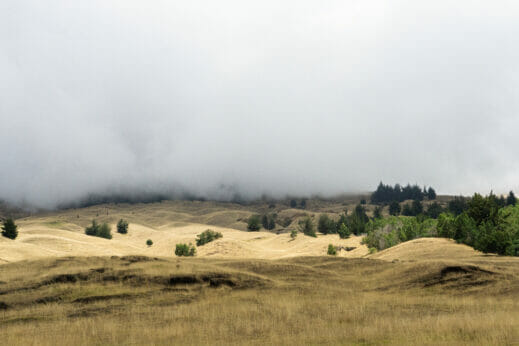
The rolling hills of Brendan Balthazar’s leased pasture up the mountain in Kula are lined with invasive trees that are difficult to maintain. (Photo: Jasmine Pankratz)
While Central Maui has a few pockets of diversified farms, seed production and pastures, most fields have simply been abandoned—only to be taken over by hardy, invasive grasses. Many hail from the African savannah, and are well-adapted to flourishing in arid, leeward regions.
With an intricately connected root system, “they do quite well when there’s a fire,” says Brewington, springing back to life stronger than ever. “So, you just get this vicious cycle of fire and grass like we’re seeing right now,” one that fuels the spread of “a grassland monoculture” that chokes out native vegetation.
Over the last 50 years, the highly flammable grasses have spread to nearly a quarter of the state, states Flint Hughes, a scientist at the USDA Forest Service (FS). “In the absence of those non-native invasive grass species, the wildfire threat in Hawaii would likely be minimal,” he adds.
Eradication efforts, however, aren’t always consistent or cohesive. Land designation and ownership run the gamut—the state’s large landholders include federal and state agencies, non-profit trusts and private holdings—and making uniform stewardship strategies across hundreds of properties a daunting proposition, says Teya Penniman, acting manager of the Maui Invasive Species Committee (MISC). (And unlike the islands of Oahu, Kauai and Hawaii, Maui has no military land, which further affects how major parcels are managed.)
Yet, “invasive species don’t care about political or legal boundaries,” she says. Each island has its own Invasive Species Committee (ISC) that identifies and prioritizes local threats, then works with private and public landowners and communities to target them. There have been success stories: MISC has almost eradicated fountain grass from Maui, although it still plagues Hawaii Island. And FS’s Flint reports that targeted control of albizia, a brittle and fast-sprouting non-native tree that easily topples during tropical storms, has helped minimize its spread.
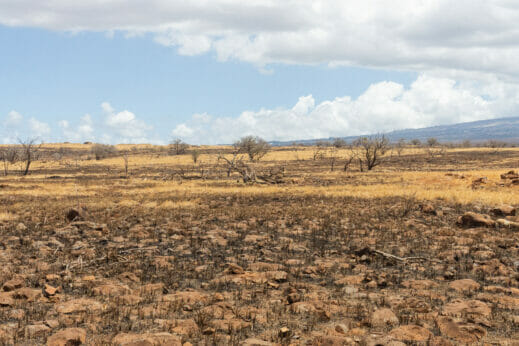
Dry grass stubble between the hard rocks that cover Brendan Balthazar’s pasture, leased from the Haleakala Ranch. (Photo: Jasmine Pankratz)
But as a program of the UH-Pacific Cooperative Studies Unit, ISCs operate without legal authority and solid funding, notes Penniman, who sees Hawaii lagging behind other states in providing adequate support, resources and initiatives. And invasive species control and fire prevention typically fall to individual landowners with little state or local direction and oversight, much less legal consequences for inadequate control. “I have never seen the political will to take on an approach like that,” adds Penniman.
And that makes agriculture all the more important as a land management strategy. Productive fields and pastures require maintenance and investment in the land—a benefit that even large-scale plantations once provided, says Hunter Heaivilin, Hawaii Farmers Union United’s (HFUU) advocacy director, despite their extractive and exploitative, mono-cropping practices. “When there’s hundreds of acres of sugarcane that is actively and intensively managed, it’s harder for invasive species to march across that,” he says.
When farmland and pastures turn idle, the economics often make land use changes tempting, says Heaivilin. And once a large parcel gets subdivided and up-zoned into more profitable uses, it rarely reverts back to farmland or pasture, he adds. “It’s a one-way valve.”
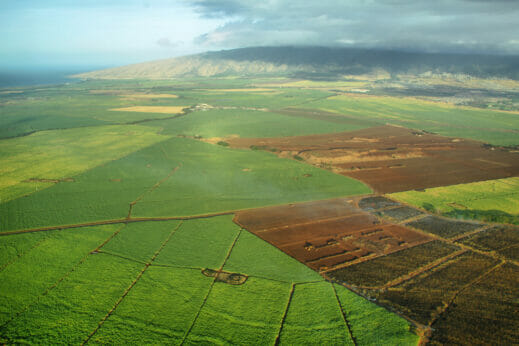
At its peak, sugar cane covered nearly a fifth of the island of Maui. (Photo: Shutterstock)
In 2018, Mahi Pono, a joint venture between a California-based, agricultural management company and a Canadian pension fund, acquired the entirety of fields left bare by HC&S. Having proclaimed a mission to practice sustainable agriculture and increase the supply of locally grown food, the company has, to date, put 10,000 acres of fields back into production with diverse crops and trees, and 9,000 acres of pasture for its cattle operation, per its website.
The agri-giant has its share of critics, who have accused Mahi Pono of everything from attempting to influence local politics to using restricted pesticides and diverting water from recent firefighting efforts. (Mahi Pono did not respond to interview requests from Modern Farmer.)
Despite the controversy, keeping thousands of acres in active production has indisputable value, says Heaivilin. But while continuity in agricultural land use is important, so is supporting a diverse mix of farms and ranches, he adds—both in crop selection and in size. Supporting small operations and multi-generational producers as well as Native homestead and traditional cultivation is crucial, not just for building resilience in the land amid a changing climate, but for ensuring food security on a remote archipelago that imports more than 80 percent of its supply.
In the meantime, as the ashes and embers settle across the island, “there’s going to be a lot of Monday morning quarterbacking,” says Balthazar, the rancher. Yet there’s no doubt in his mind as to what drove the disaster.
“If there was [proper] land management,” he says, “there wouldn’t be the fuel to create these huge flames traveling down the highways.”